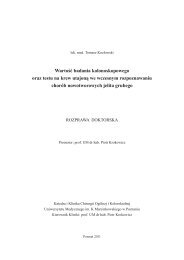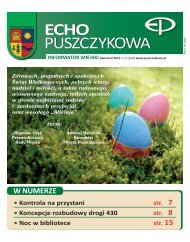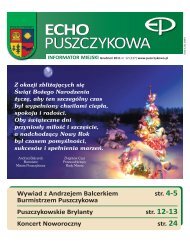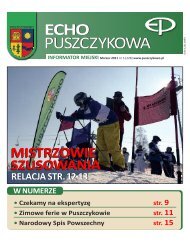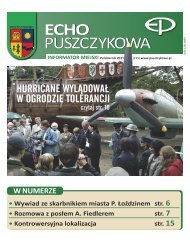MILITARY PHARMACY AND MEDICINE
MILITARY PHARMACY AND MEDICINE
MILITARY PHARMACY AND MEDICINE
You also want an ePaper? Increase the reach of your titles
YUMPU automatically turns print PDFs into web optimized ePapers that Google loves.
© Military Pharmacy and Medicine • 2012 • 4 • 112 – 118allow for reconstruction of various fields of life.During excavations we find items, which couldhave served during medical or hygienic procedures.Not many archeologists are concernedwith medical or surgical instruments from prehistoricaland medieval times. Hygienic items:knives, razors, pincers, and mirrors are morebroadly described. There are numerous publicationsin foreign literature discussing surgical andmedical instruments from the Roman periodof Iron Age (since the 1st century A.D. untilabout 375 or the end of Roman Empire) foundby the archeologists within the region of RomanEmpire.Anthropological sources (bone material) allowfor observing pathological changes (injuries, illness)and traces of intentional procedures performedby the first “surgeons.” Paleoanthropologyis concerned with morphological analysis ofhuman skeletal remains. The goal of those studiesis to determine important biological features (sex,age, height, body mass) of individual and entiregroups of people. Paleopathology is concernedwith disease lesions, developmental changesand traumatic injuries visible on excavated skeletalmaterial. It should be noted that this field ofknowledge is at the border of paleoanthropologyand medicine. We are mainly interested in thestructure of health in a given population [3].Very little room is devoted in Polish scientificliterature to prehistoric medicine. It is probablya result of scarce sources and difficult access tothem. There are publications concerning developmentof medicine in the Middle Ages. Here, wecan already encounter written sources: chronicles,annals and letters. They provide informationon the first Polish physicians, famines and epidemicsthat tormented the contemporary society.Authors of numerous publications [4,5,6] pointedto the need for further studies on history of medicinebased on anthropological sources. Findingthe signs of diseases besetting people ages ago inskeletal material or soft tissues may help us understandpathological phenomena occurring in thebody, as many diseases have been known sinceneolithic era (since about 5400 until 2200 /2100B.C.). Going back in time allows for noting diseasesymptoms and investigating the mode oftransmission of some diseases, particularly theones causing epidemics, with groups of people.Review articleImmunological changes occurring in a human asa result of civilization progress as well as environmentaland social changes constitute anothercurious phenomenon. In prehistorical times, onlybiologically strong individuals reached adult age.Mortality of women in childbearing age was highand mean lifespan was shorter for women thanfor men. Today the situation became reversed, aswe know from demographic studies [7].Among the Slavs, as in case of other nations,medicine probably grew from everyday experiences,beliefs and customs. The cause of the diseasewas seen in natural factors such as: poornutrition, dirtiness, infections, as well as supernaturalfactors: witchcraft and enchantments.According to the beliefs of ancient Slavs, deitieswere also responsible for health or sickness [8].Archeological sources on medicine are scarce.First of all, we would like to understand how, withwhat and where people were treated. The mostarcheological sources, on which we may base ourdeliberations, come from early Iron Age (fromthe beginning of 1st century B.C. until about4 th century B.C.) and the Middle Ages (from 7 thcentury until half of 16th century). Here, we canmention immobile sources: remnants of medievalhospitals and baths, as well as mobile ones: medicalinstruments, medicine containers (e.g. madefrom antlers), pharmaceutical containers. Fromthe earliest times, people attributed therapeuticproperties to various talismans made of bone,stone or fossils. Belemnites – fossilized molluskshells (cephalopods), also called “lightningarrows”, were particularly valuable. They wereapplied to the affected areas, but also ground topowder and given to drink. Belemnites were usedfor treatment of: rheumatism, colic, eye diseasesand during childbirth; they also protected frombewitchment [9]. Use of talismans was popular infolk medicine. Animal horns and bones, as wellas roots of particular plant species were most frequentlyused as materials.Archeobotanical studies of plant fossils provideinformation on plants present in humanenvironment, including edible ones, grownor derived from natural positions. Among thearcheobotanical material, we may also distinguishtherapeutic plants. Plants used in medicinecould be grown in home gardens or gatherednear human settlements, cities or villages.112 http://military.isl-journals.com



